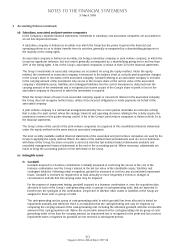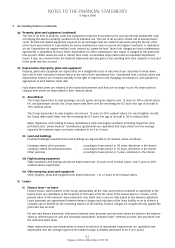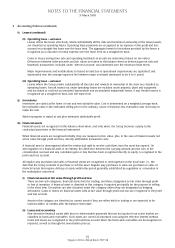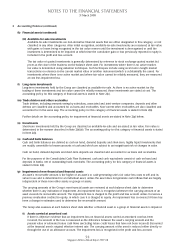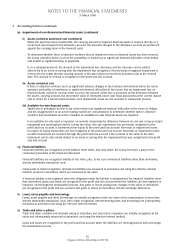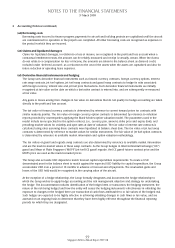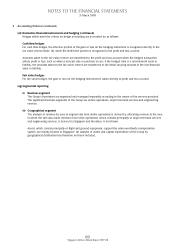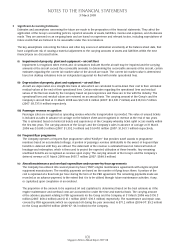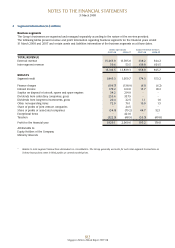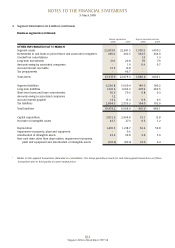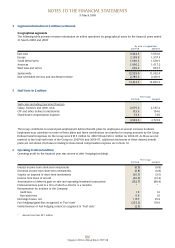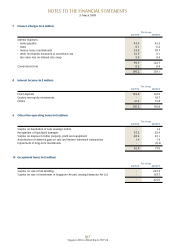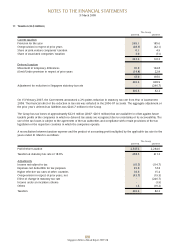Singapore Airlines 2008 Annual Report Download - page 101
Download and view the complete annual report
Please find page 101 of the 2008 Singapore Airlines annual report below. You can navigate through the pages in the report by either clicking on the pages listed below, or by using the keyword search tool below to find specific information within the annual report.Singapore Airlines Annual Report 2007-08
99
2 Accounting Policies (continued)
(ad) Borrowing costs
Borrowing costs incurred to finance progress payments for aircraft and building projects are capitalised until the aircraft
are commissioned for operation or the projects are completed. All other borrowing costs are recognised as expenses in
the period in which they are incurred.
(ae) Claims and liquidated damages
Claims for liquidated damages, in relation to a loss of income, are recognised in the profit and loss account when a
contractual entitlement exists, the amount can be reliably measured and receipt is virtually certain. When the claims
do not relate to a compensation for loss of income, the amounts are taken to the balance sheet as deferred credit,
included under “deferred account”, as a reduction to the cost of the assets when the assets are capitalised and also for
future reduction of operating lease expenses.
(af) Derivative financial instruments and hedging
The Group uses derivative financial instruments such as forward currency contracts, foreign currency options, interest
rate swap contracts, jet fuel options, jet fuel swap contracts and gasoil swap contracts to hedge its risks associated
with foreign currency, interest rate and jet fuel price fluctuations. Such derivative financial instruments are initially
recognised at fair value on the date on which a derivative contract is entered into, and are subsequently re-measured
at fair value.
Any gains or losses arising from changes in fair value on derivatives that do not qualify for hedge accounting are taken
directly to the profit and loss account.
The fair value of forward currency contracts is determined by reference to current forward prices for contracts with
similar maturity profiles. The fair value of foreign currency option contracts is determined by reference to valuation
reports provided by counterparties applying the Black-Scholes option valuation model. The parameters used in the
model include terms specified for the option contract, (i.e., currency pair, amount, strike price and expiry date), and
prevailing market values for volatility and spot rates at date of valuation. The fair value of interest rate contracts is
calculated using rates assuming these contracts were liquidated at balance sheet date. The fair value of jet fuel swap
contracts is determined by reference to market values for similar instruments. The fair value of jet fuel option contracts
is determined by reference to available market information and option valuation methodology.
The fair values of gasoil and regrade swap contracts are also determined by reference to available market information
and are the mark-to-market values of these swap contracts. As the Group hedges in InterContinental Exchange (“ICE”)
gasoil and Mean of Platts Singapore (“MOPS”) jet-fuel-ICE gasoil regrade, the ICE gasoil futures contract price and the
MOPS price are used as the mark-to-market prices.
The Group also set aside USD deposits to match forecast capital expenditure requirements. To create a USD
denominated asset in the balance sheet to match against the expected USD liability for capital expenditure, the Group
accumulates USD over a period of 10 months in advance of forecast aircraft payments. The revaluation gains and
losses of the USD held would be recognised in the carrying value of the aircraft.
At the inception of a hedge relationship, the Group formally designates and documents the hedge relationship to
which the Group wishes to apply hedge accounting and the risk management objective and strategy for undertaking
the hedge. The documentation includes identification of the hedged item or transaction, the hedging instrument, the
nature of the risk being hedged and how the entity will assess the hedging instrument’s effectiveness in offsetting the
exposure to changes in the hedged item’s (or transaction’s) cash flows attributable to or fair values of the hedged risk.
Such hedges are expected to be highly effective in achieving offsetting changes in cash flows or fair value, and are
assessed on an ongoing basis to determine that they have been highly effective throughout the financial reporting
periods for which they are designated.
NOTES TO THE FINANCIAL STATEMENTS
31 March 2008



